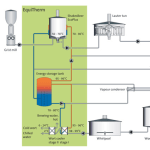 One major focus of Krones’ process technology lies in the development of system components that make use of energy-saving potentials in order to minimise environmental impact and progress resource-economy.
One major focus of Krones’ process technology lies in the development of system components that make use of energy-saving potentials in order to minimise environmental impact and progress resource-economy.In terms of energy consumption, wort production is the process step in a brewery that requires the most primary energy in the form of heat. It is here that an energy recirculation system called EquiTherm, newly developed by Krones AG’s Steinecker subsidiary, comes into play.
Depending on the particular brewing process being used, EquiTherm produces primary energy savings of 20 % and more. The Bergquell Brewery in Löbau is achieving primary energy savings of 32 % with this system in its brewing process, signposting the way forward.
Besides the familiar energy recirculation feature between the lautered-wort heater and the wort boiler, fed by the vapour condenser, EquiTherm enables a brewery’s consumption of primary energy in the brewhouse to be substantially reduced still further. For this purpose, energy is removed from the boiled wort at a high temperature, so as to replace the primary energy used in the mashing process to the maximum degree possible.

One precondition for this concept to succeed is use of the design-enhanced ShakesBeer EcoPlus mash kettle, which with its pillow plates and a special heating-surface flow pattern ensures a very high heat flow even at low admission temperatures.
At the Bergquell Brewery in Löbau, this system has enabled primary energy consumption in the brewing process to be reduced by 32 %. This is all the more remarkable in that before installing EquiTherm the brewery already had a state-of-the-art brewhouse, a mere two years old. For an annual output of 200,000 hectolitres, the EquiTherm system now installed is enabling the Bergquell Brewery to save about 500,000 kilowatt-hours of primary energy a year.
Besides the high energy savings, this system also significantly downsizes consumption levels for both fresh water and electricity.



